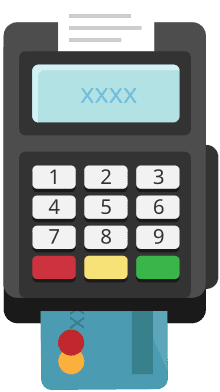Take your photography hobby and turn it into a thriving photography small business. From registration to marketing, we've got you covered in our guide.
Our content reflects the editorial opinions of our experts. While our site makes money through
referral partnerships, we only partner with companies that meet our standards for quality, as outlined in our independent
rating and scoring system.

If you’re a photographer looking to make your passion your job, we’re here to teach you how to start a photography business!
Wedding, engagement, graduation, family, baby, headshot, or even cosplay photography — keep reading to learn how to get started, brand your studio, find the best web/payment platforms, and market yourself!
Why Start A Photography Business?
Starting a photography business, even if it’s just a side hustle/part-time gig, allows you to be your own boss. While increasing the flexibility of your schedule, you get to do impactful work with those in your community by capturing some of the most important moments in their lives.
While the free food at weddings, sweet baby smiles, and recognition for your work may seem like payment enough, you can set your own pay rates and control how much cash you bring in. You can choose to work from a studio (one you could even run from your home), exclusively shoot outdoors, or even a combo of both!
The market for photography may wax and wane, but the fact remains that people will always want to celebrate and commemorate special moments in their own and their loved ones’ lives. Models, business professionals, and actors will always need professional headshots. Content creators will always need content.
Do I Need A License To Start A Photography Business?
The answer to this question depends on your state, and even city, of operation. Contact your state licensing board and any other municipalities to see if you need to apply to receive a license or permit.
However, you will need to decide what kind of structure you will run your photography business under. You can remain a sole trader/proprietor, corporation, or limited liability company (LLC). The most common choices for small, independent business owners are sole traders/proprietorships and LLCs.
Are There Any Other Requirements For A Photography Business?
You don’t need a degree or certification to start your own photography business. But it can make your business and skills more credible to new customers/clients to have a degree, certification, or have completed a relevant course of study.
While photography businesses don’t have strict requirements like some industries, there are a couple of things we would recommend that you do before officially starting your own business:
- Decide Your Business Structure: Your photography business will remain a sole proprietorship until you file paperwork to become another type of entity. Read our complete guide on types of business structures before you make your decision.
- Research Business Insurance Policies: As a photographer who may be asking subjects to trek over uneven terrain or pose in potentially dangerous positions, liability insurance isn’t the worst idea. A general liability insurance policy protects you and your business in case of a lawsuit or accident, including property damage, bodily injury, or false advertising claims. Your equipment is expensive, so do what you need to protect it! Learn more about the types of business insurance you may need.
9 Steps To Starting Your Own Photography Business
We’ve covered some basics, so now it’s time to get into the steps you need to take to get your photography business off the ground!
1) Make A Business Plan
While the term “Business Plan” might sound daunting, it isn’t as scary as it may seem! A business plan is simply a written description of your planned business and business strategy. It will outline your vision of how your business will be organized, operate, and be profitable.
Business plans look different for every business, even businesses in the same industry. They’re highly personalized, but they all include some similar elements:
- Executive summary
- Company description
- Market analysis
- Sales and marketing strategy
- Operating plan
- Organization and management team
- Financials
Use this plan as you’re first getting started to set some goals, build out your marketing strategy, and predict future expenses.
Read our article on how to write a one-page business plan for more in-depth steps and information.
2) Find Funding For Your Business
You’ve made your business plan and have a basic idea of how you will operate your business and some future expenses. Break down exactly what it will cost to start your photography business. Do you need to purchase equipment, such as a camera, lights, backdrops, and props? What about editing software and a web platform to share files with your clients?
When making this hypothetical budget, be sure to account for things such as licenses/permits, website/domain fees, payments for any insurance policies, and future marketing costs.
3) Find The Right Technology & Software
Your equipment and editing software can make or break your photography business. High-quality, well-edited pictures delivered on time for a reasonable price will make you stand out against your competitors.
Here are the types of software you may consider purchasing:
- Photo Editing Software: This is a non-negotiable purchase. You can be great at taking photos, but the lighting will never be perfect; there will always be a hair out of place, and having this software allows you to branch out into more creative kinds of photography.
- Video Editing Software: While videographers are an entire industry of their own, you may choose to dabble in some behind-the-scenes recording or expand your offerings to include professional video services. Some photo editing software will allow you to edit videos, but you might get better features and quality from software specifically designed for the task.
- Document Editing Software For Contracts: You may be able to use the same software for this and file sharing, but at the very least, you should have a Google Drive or Adobe PDF account. You will need to make your own contracts to either send to clients to sign virtually or bring with you to your photo shoots.
- File-Sharing Software: We wouldn’t recommend emailing final photos to your client because the quality will likely be reduced. Consider using portable storage devices, such as USB drives, CDs, and external hard drives. Google Drive or Dropbox are other popular options for new photographers.
- Scheduling Software: Make your life easier and allow clients to schedule appointments via your website or dedicated scheduling software. This way, you can manage the appointments after they’ve been made, not over text or Instagram DMs, where messages are bound to get lost and clients frustrated.
- Accounting Software: This isn’t something you will likely need at the very beginning of your business journey. It will be important as you begin to bring money in, receive payments from clients, send invoices, and potentially hire employees. You can read our article to learn about the best accounting software for small businesses.
This is not an exhaustive list, but it will get you started off on the right foot!
4) Set Your Rates
The main perk for most photographers is that they get to set their own rates. Rates can vary from photographer to photographer, even in the same city, depending on your experience level, the kinds of photography you offer, and the locations of your photo shoots.
Multiple sources offer the figure of $150-$350 per hour to hire a photographer. Event photographers typically fall on the more expensive end of the scale, while school sports/class photos tend to be a little cheaper.
Photographers who charge the most tend to have at least five years of experience, photograph day-long or extended events (such as weddings), or work as commercial photographers in real estate or even high-end car sales.
While determining your prices, we recommend researching the rates of local competitors or other photographers in your niche. After you have a better idea of that range, consider the budget you made in your business plan, the taxes you’ll have to pay on your wages, and the time it takes to prepare for a photo shoot.
5) Set Your Prices
Now that you know how much you’ll be charging per session/event, it’s time to decide what you’re going to charge for digital and physical prints/files. Much of this will be determined by the company you use to print your finished products.
You can offer polished photo books, large canvases, and/or portraits printed on metal or wood, but the most lucrative and accessible way is to offer all of the images on a USB or other physical drive. It’s up to you if you want to offer all of the photos with edits made, unedited photos, or different amounts (10, 15, etc.) of photos.
The world is your oyster when it comes to how you give your clients their pictures. You can even decide not to offer anything other than digital files and allow your clients to find their own printing services. You could find a local printer and partner with them to offer lower rates for your clients in exchange for promotion or part of their profits. Whatever works for you and your clients is the best choice!
6) Register Your Business
This step is most likely going to be optional for your photography business.
If you do decide to operate as a sole proprietorship or partnership, you don’t need to register your business because it will exist as an extension of yourself.
There’s a good chance you won’t need to register your business with state or federal agencies. You will likely need to file for a local business permit in your city or county, and your business will be subject to local taxes.
Learn more about how to register your business in our complete guide.
7) Establish An Online Presence
In 2023, photographers must have a strong web presence. There are a few ways we recommend building this presence and setting yourself up for success:
- Make A Website: Make yourself an attractive, easy-to-use website that will become the online home for your photography business. This will add credibility to your business and increase potential clients’ confidence in your ability. There are many user-friendly and cost-effective website builder tools that you can use to set up a site in a matter of minutes!
- Make Social Media Accounts: To get started using social media for marketing, first set up accounts for your photography business on social media sites you know your clients use most frequently. For photographers, that will typically be Instagram and Facebook because of their capability to upload large, mostly high-quality photos. Include important information, such as the photography you specialize in, a link to your website, and examples of your previous work.
- Create A Yelp Page: Creating a Yelp page will encourage happy clients to leave good reviews and give you the opportunity to address unhappy clients properly. This can help direct new clients to your business. You can consider adding a testimonial widget to your website if your builder allows it as well.
8) Get Paid
The website builder you choose might include its own payment processing software, which could be perfect for your photography business. If you don’t like the in-house processor for one reason or another, plenty of options offer integrations with your existing website.
No matter what processor you choose, you’re going to need to make sure you can take cards and/or send invoices. You can have a physical card reader or a QR code that allows your clients to scan and link to your payment processing software; no physical card is required.
We’ll talk more about potential payment processors later in the article.
9) Find Clients
To have a photography business, you’re going to need to have clients to photograph!
Identify your niche — quirky headshots, pet photography, nontraditional weddings, etc. — and start taking some photos. Offer free staged engagement shoots, discounted rates for friends and family, and model calls, anything to get some examples of the work you can do into your portfolio if it’s currently empty.
The business plan you made earlier will come in handy again at this stage in the game. Your marketing strategy is not set in stone; it should change depending on your current network and intended audience.
Here are some ways you can consider marketing yourself:
- Start an e-newsletter using email marketing software and add your current network as subscribers
- Allow new clients to subscribe to email communications via your social media or a button on your website
- Use social media to announce your new business
- Advertise in person, and think about places your clients are likely to be: bridal boutiques, pet stores, daycares, etc.
- Share customer reviews/testimonials
- Make some 21st-century business cards with QR codes and an eye-catching design
- Take advantage of services that allow you to create virtual business cards, so you don’t have to worry about re-prints
The Best Web Platforms For Photographers
Not to be too redundant, but it’s crucial for you to have a strong web presence, a reliable payment processor, and an easy way for clients to schedule sessions with you. The great news is that sometimes the solution to all three needs can come in a single web platform!
Read on to learn more about some of our favorites.
Shopify
Shopify’s online store is an easy-to-use platform that offers a free trial, advanced design tools, six different plans, an easy-to-use POS system for in-person payments, and even built-in marketing features. Monthly rates start as low as $5.
As a web platform, Shopify offers a fully customizable website builder that requires no coding! You can choose from thousands of themes, apps, and integrations. Shopify offers a free three-day trial and the ability to purchase your custom domain name directly through them.
Check out our Shopify review for more info about what this vendor offers.
Square
As we cover in our Square Online review, Square is a cost-effective eCommerce solution that integrates directly with Square POS. Square offers a free plan, free web hosting, and, like Shopify, you don’t need coding knowledge to use the website builder to make your online store. Square offers more options for accepting in-person payments and even a free card reader.
If you wish to get rid of the Square ads on your site, need more than 500MB of storage, or want to use a custom domain, you will need to upgrade to a paid plan. Plans start at $12/month, billed annually.
Lightspeed
Lightspeed is the priciest option on this list, but it offers some unique features for small business owners. The most interesting of these features is the Customer Loyalty Program function. Lightspeed Loyalty allows you to reward your returning clients with a point-based loyalty program. Lightspeed also offers custom pricing for POS systems, making it easy to choose exactly what you need for your business.
Lightspeed is definitely more tailored for retailers, but it has plenty of useful features for photography businesses, including gift certificates and receipts. Lightspeed eCommerce allows your clients to schedule their own appointments and send confirmations and reminders, offers reports you can run to determine the health of your business, and marketing features that can help with your SEO score and social media presence. Plans start at $69/month, billed annually.
Our Lightspeed Retail review goes into more depth on this vendor.
How To Start A Photography Business: FAQs
What type of photography is most profitable?
Commercial photography tends to be the most profitable, even if it isn’t the most fun.
What photography is in high demand?
Photojournalism (typically photographing for a news source) is always in high demand, especially now with the prevalence of online articles needing eye-catching photos to win clicks from readers.
What are the 5 top paying states for photographs?
The five top-paying states (in order) are New York, Minnesota, Connecticut, Massachusetts, and Vermont.



 Experience competitive rates, excellent customer support, and a fast & easy claim process. Request a free analysis today.
Get Started
Experience competitive rates, excellent customer support, and a fast & easy claim process. Request a free analysis today.
Get Started
 Experience competitive rates, excellent customer support, and a fast & easy claim process. Request a free analysis today.
Get Started
Experience competitive rates, excellent customer support, and a fast & easy claim process. Request a free analysis today.
Get Started